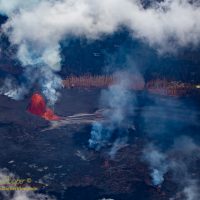It is the question everyone on the island would like an answer for… How long will this eruption last?

This lava has covered much of the Kapoho area and built new land out almost a kilometer beyond the old shoreline into waters that were once over hundreds of meters deep. In the process well over 700 homes and farms have been destroyed and permanently altering the landscape of the Puna district.
In an attempt to summarize the current eruption for residents and county emergency planners the USGS has just published a detailed report on the current eruption conditions, hazards, and likely scenario’s moving forward.
In addition to concisely reporting the eruption to this point the report goes on to compare this eruption to historical eruptions in the Lower East Rift Zone. These older eruptions demonstrate a range of possible scenarios we might observe as the current eruption plays out.
One fact? The 2018 eruption is much larger than any recent Kilauea eruption.
In the report the USGS lays out various hazards the ongoing lava flows present. Instabilities in the channel could overflow or rupture, threatening large areas north of the flow that have so far remained undamaged, including numerous homes and farms.
Of course, it is the prognosis part of the report that everyone skips to when reading it. Where do we go from here?
If the ongoing eruption maintains its current style of activity at a high eruption rate, then it may take months to a year or two to wind down. While this seems to be the most likely outcome, a pause in the eruption, followed by additional activity, cannot be ruled out, nor can an abrupt cessation or a transition to steady, longer‐lived activity at a lower effusion rate. – USGS Report July 15, 2018
Not very encouraging is it? This is not the answer the residents of Puna want to see. The scenario of a long lived eruption, perhaps at a lower volumes similar to the three decade Puʻu Oʻo eruption, is not an encouraging possibility.

